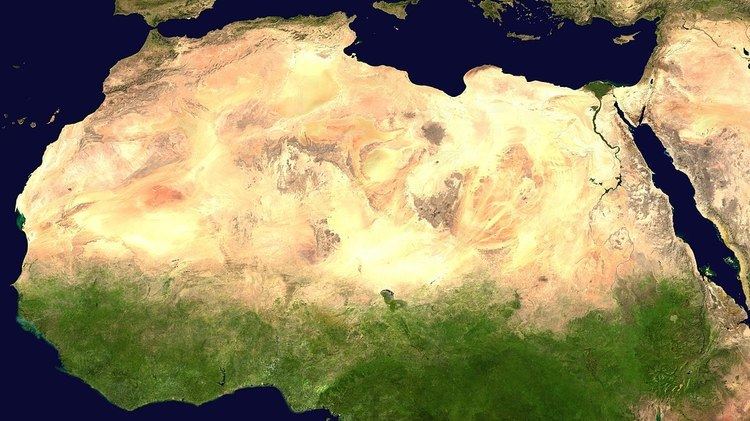 | ||
Desert greening is the process of man-made reclamation of deserts for ecological reasons (biodiversity), farming and forestry, but also for reclamation of natural water systems and other Life support systems. It is done by various methods. So far only arid and semi-arid desert are meant when using the expression. Icy deserts are considered unsuitable. Desert greening is an important topic as it can help solve global water, energy, and food crises. It pertains to roughly 32 million square kilometres of land.
Contents
Methods
Water
Desert greening is more or less a function of water availability. If sufficient water for irrigation is at hand any hot, cold, sandy or rocky desert can be greened. Water can be made available through saving, reuse, rainwater harvesting, desalination, or direct use of seawater for salt-loving plants. These different paths have unique features, i.e.: conserving water is a cheap solution. Reuse of treated water and the closing of cycles is the most efficient because closed cycles stand for unlimited and sustainable supply - rainwater management is a decentralized solution and applicable for inland areas - desalination is very secure as long as the primary energy for the operation of the desalination plant is available - Direct use of seawater for seawater agriculture is the most potent, only limited by the need for pumping up the water from sea-level.
Novel type of desalination is done with the Sahara Forest Project. This project uses solar stills for the generation of the freshwater. Another novel technique is cloud seeding, either by artificial means or through the action of cloud-seeding bacteria that live on vegetation (e.g. Pseudomonas syringae). Another, "atmospheric water generation" or air to water, uses dehumidification and is used by the military for potable water generation. However this technology uses 200 times more energy than desalination, making it unsuitable for large scale desert greening. An exception is the Integrated Biotectural System, which performs air-to-water in a greenhouse - a closed environment with optimized atmospheric conditions.
Water distribution
Once the (fresh or sea)water has been attained in centralized systems it must be distributed. This can be done using dug canals or in some instances aqueducts (which are both the least attractive option since they allow much water to be evaporated), troughs (as used in the Keita Project), earthenware piping (semi-open or closed) or even underground systems i.e. qanāt.
Depending on the method of distribution of the water, it can then be provided on different methods to the plants. A costly solution (used only on pipes) is drip irrigation. Other methods are the use of wadis (basically V-shaped ponds dug in the earth) or by simply planting the trees in holes inside/over the water pipe itself. The tree's roots can then suck the water straight from the water pipe (used in qanāt, hydroponics, ...) A similar technique can be done with semi-open pipes (i.e. dug throughs in the Keita Project).
Side effects
The use of water is, however, not always without problems. Desert greening by the Helmand and Arghandab Valley Authority irrigation scheme in Afghanistan significantly reduced the water flowing from the Helmand River into Lake Hamun and this, together with drought, was cited as a key reason for the severe damage to the ecology of Lake Hamun, much of which has degenerated since 1999 from a wetland of international importance into salt flats.
Trees
A main component of desert greening is the planting of trees. Trees store water, raise water from underlying aquifers, reduce evaporation after a rain, attract animals (and thereby fertility through feces), and they can cause more rain to fall (by temperature reduction and other effects), if the planted area is large enough.
Example
The soil of the Thar Desert in India remains dry for much of the year and is prone to wind erosion. High velocity winds blow soil from the desert, depositing some on neighboring fertile lands, and causing shifting sand dunes within the desert, which buries fences and blocks roads and railway tracks. A permanent solution to this problem of shifting sand dunes can be provided by planting appropriate species on the dunes to prevent further shifting and planting windbreaks and shelterbelts. These solutions also provide protection from hot or cold and desiccating winds and the invasion of sand. The Rajasthan Canal system is the major irrigation scheme of the Thar Desert and is intended to reclaim it and to check spreading of the desert to fertile areas.
Prevention of shifting sand dunes is accomplished through plantations of Acacia tortilis near Laxmangarh town. There are few local tree species suitable for planting in the desert region and these are slow growing. The introduction of exotic tree species in the desert for plantation has become necessary. Many species of Eucalyptus, Acacia, Cassia and other genera from Israel, Australia, US, Russia, Zimbabwe, Chile, Peru, and Sudan have been tried in the Thar Desert. Acacia tortilis has proved to be the most promising species for desert greening. The jojoba is another promising species of economic value which has been found suitable for planting in these areas.
